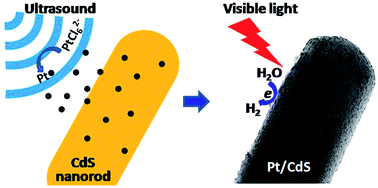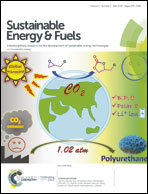Sonochemical deposition of ultrafine metallic Pt nanoparticles on CdS for efficient photocatalytic hydrogen evolution†
Abstract
Noble metal Pt is one of not only the most effective cocatalysts in hydrogen evolution, but also the most widely used reference cocatalysts in the development of non-noble metal cocatalysts. The efficient and optimum use of noble metal Pt as a cocatalyst is of great significance. In this work, we demonstrated a rapid and facile sonochemical approach to the deposition of Pt on CdS nanorods with H2PtCl6 as a precursor in an aqueous solution of methanol, which was achieved by the ultrasonic irradiation in an ultrasonic cleaning bath. The resulting Pt-deposited CdS (Pt/CdS) exhibits remarkably high efficiency for hydrogen evolution from water splitting, with a highest H2 evolution rate of 24.15 mmol h−1 g−1 over 0.5 wt% Pt/CdS. Various characterizations revealed that the ultrasonic irradiation can effectively drive the completion reduction of Pt4+ in the precursor (H2PtCl6), and the tight adherence of the resulting ultrafine metallic Pt nanoparticles with an average size of 1.75 nm to the surface of CdS nanorods, both of which would contribute to the enhanced photocatalytic H2 evolution. This work, we believe, offers a simple but effective approach to the deposition of noble metal Pt as an efficient cocatalyst on CdS for high photocatalytic H2 evolution.

- This article is part of the themed collection: 2019 Sustainable Energy and Fuels HOT Articles


 Please wait while we load your content...
Please wait while we load your content...